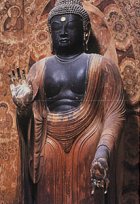Early Heian Period |
|||
|
The Early Heian Period spanned a period between 794 AD and about 900 AD. Before the influx of Chinese influences, Japanese architecture used simple construction techniques and little decoration and ornamentation. It used natural and locally available materials. As the Japanese strived to create the architectural equivalent of monumental Chinese architecture, the idea of simplicity in design was ignored in favor of a more elaborate design. However, it is during this time that the T’ang dynasty in China, which the Japanese so greatly revered, began to decline in power and influence on the Japanese. Thus the Early Heian Period marked a change in the way Japanese architecture developed. The temples of this period moved back into the many mountains and hills of Japan to escape the city. The capital city was moved from Nara because the temples were becoming too politically influential. Thus much of the funding that the temples relied upon was lost. Neither the funding nor the political backing to construct new structures within the city was available, so new temples moved to the mountains where people began practicing the newly introduced esoteric systems of Buddhism called Tendai and Shingon Buddhism. The lack of funding also meant that the architecture could not be as elaborate or as monumental as the temples of the Nara period. These new mountain temples also abandoned the strict symmetrical plan in favor of a much more uneven and convoluted plan, that stemmed from the lack of smooth topography. The mountainous terrain they began to inhabit made it impractical to attempt a plan based on a strong central axis. Instead, the various halls of the temples were placed on many different levels and wherever a flat piece of land could be found. The topography also contributed to the smaller size of temples from this period, because larger ones simply would not fit anywhere. Many of the temples of this era had buildings that were placed at irregular intervals and were supported by rocks or wood trestles on the uneven ground.
|
||
Home |
History |
Bibliography |
Links |
